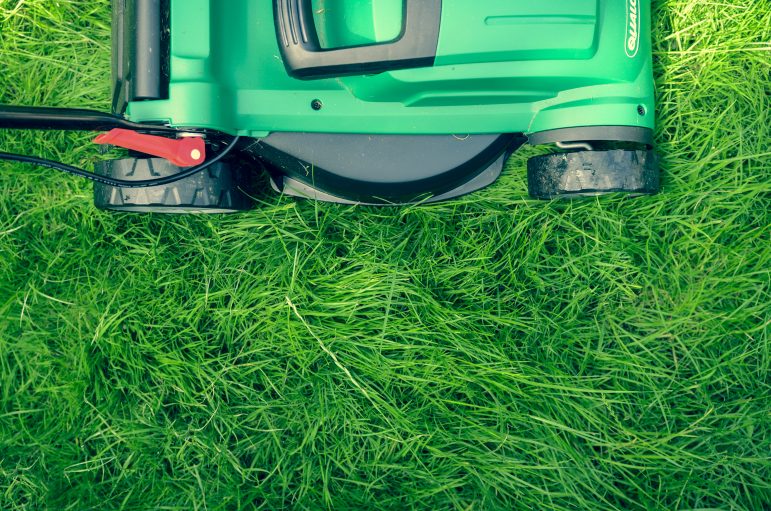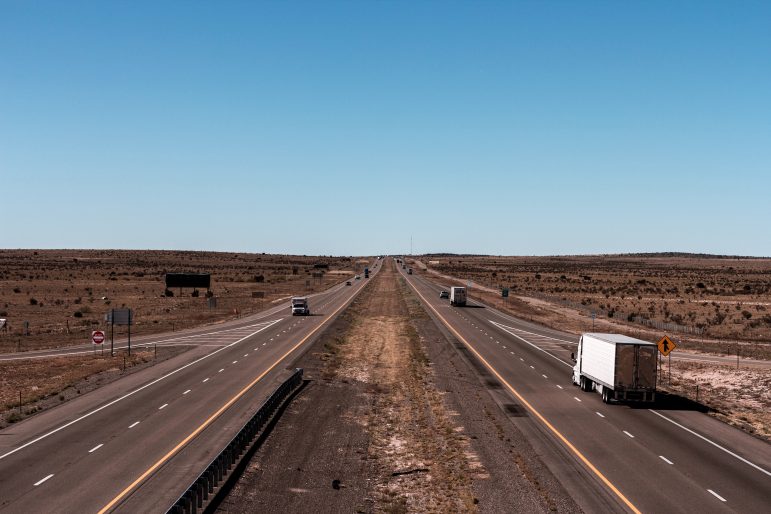Big rig trucks and lawn equipment face stricter pollution requirements under a suite of landmark rules approved today by California’s clean air regulators.
Manufacture of new, polluting models of lawn and garden equipment will be phased out in 2024 under the rule unanimously adopted by the California Air Resources Board, despite opposition from gardeners and landscapers.
And in a separate rule, big rigs will have to undergo periodic smog checks, just like cars, except most trucks will undergo the tests remotely through onboard diagnostics.
California is the first in the nation to require heavy-duty trucks to undergo smog checks or mandate zero-emission lawn equipment.
Together, the two rules are expected to avoid 8,400 premature deaths linked to air pollution and result in health benefits of more than $84 billion. The trucks rule alone “is the largest emissions reduction measure since the truck and bus rule, and that was 2008,” said Jason Hill-Falkenthal, an air resources supervisor with the board’s mobile source control division.
The total cost to comply with the two rules: An estimated $8 billion spread over more than 20 years.
Zero-polluting lawn mowers, leaf blowers
Under the new lawn equipment rules, manufacturers must meet zero-emission standards for new models of yard equipment, including weed whackers, lawn mowers, leaf blowers and smaller chain saws, in three years. Residents and workers, however, can continue to use and repair their gas-powered equipment.
Gardeners and landscaping associations raised concerns about higher costs to buy the equipment and additional batteries needed for a day’s work.
“The cost to transition would be significant and probably kill my small business,” Elizabeth Burns, president of Zone 24 Landscaping Inc., based in Torrance, said today at the hearing. “One other issue is the technology is not yet there for battery life and that’s super important.”

Also, under the new rules, new portable generators must meet stricter emission standards in 2024 and reach zero-emissions for model-year 2028 generators.
At a three-hour public hearing today, much of the opposition came from the RV industry and owners, who urged the board, unsuccessfully, to exempt their generators. Also, rural officials warned that alternatives to portable generators are cost prohibitive and do not perform adequately.
“Power outages in rural areas are frequent, can last for several days and are becoming more common,” said Dave Johnston, air pollution control officer for Eldorado County. “Forcing moderate to low-income rural residents to do without power for extended periods to achieve small emission reductions in these areas that are already in attainment is unconscionable.”
In a presentation, air board staff said the longer lead time of four more years for portable generators will allow “manufacturers to develop models with more energy storage and power delivery.”
Small engines powering lawn equipment and portable generators are a surprisingly large source of California’s air pollution, belching more smog-forming pollutants than cars and SUVs in California. Using a commercial leaf blower for an hour spews as much as driving 1,100 miles in a new car, roughly from Los Angeles to Denver, the air board reports.
Air board officials estimate that 93% of the equipment covered by the new standards would be zero emissions by 2035, compared to only 54% under current rules. The rule will prevent almost 900 premature deaths through 2043, with the health benefits expected to reach $8.82 billion — offsetting expected costs of about $4 billion to achieve the emissions, according to air board estimates.
Earlier this year, California legislators passed a law calling for new state regulations to bar emissions from yard equipment and portable generators.
“These engines cause asthma, cardio respiratory disease and increase cancer risk and premature death,” Assemblymember Marc Berman, a Democrat from Los Altos who co-authored the bill, said at today’s hearing, reminding board members that California is home to seven of the ten smoggiest cities in the country.
Still, he said, “it is important to emphasize that the regulation is not a ban on use. Nobody will have to give up or stop using equipment they already own.”
The lawn equipment rules build on existing regulations that have helped cut emissions from small off-road engines by half over the past 20 years. But in the absence of new regulation, their emissions are expected to grow to nearly twice those from cars and SUVs by 2031.
The mandate instead is aimed at manufacturers, air board staff say, not gardeners and landscapers, who can continue to use and repair gas-powered equipment even after the new rules take effect.
Manufacturers will be permitted to meet the emission standards using credits earned under previous rules, meaning that the phaseout won’t be instantaneous. The board also agreed to extend the timeline for certain pressure washers, pushing back zero-emission requirements to 2028. Staff acknowledged a lack of availability of new technology and their high power demands.
Still, Jeff Coad, vice president of marketing and management at manufacturer Briggs and Stratton, said the timeline is unrealistic for manufacturers and small businesses.
“The development time for each machine to convert from gas power to an electrified drive train can take two years” for each manufacturer, for each product, he said. And there’s been limited commercial uptake due to several issues, he said. “Battery runtime, lack of infield charging options, high cutting performance requirements and the very high price of electrified machines.”
California regulators acknowledge that small business landscapers, which make up more than 99% of the landscaping businesses in the state, may be significantly affected by the costs of the new rules.
“Purchasing all new (zero emission equipment) in addition to the batteries may be burdensome. However, landscapers using (zero emission equipment) may realize net cost-savings within the first few years of purchase due to decreased fuel and maintenance costs,” staff reported.
To help, California legislators carved out $30 million to provide incentives for small independent gardeners and landscaping businesses to help cover the costs of transitioning to zero-emission equipment. The move follows similar incentive programs offered by regional air regulators in Southern California and the San Joaquin Valley.
“What we’ve learned through these efforts is that zero emission equipment is more readily available, but significant challenges remain and widely deploying this equipment,” said Tom Jordan with the San Joaquin Valley Air Pollution Control District. “This transition will not be an easy one that will require ongoing evaluation of technologies and will need significant new funding.”
Sandra Giarde, executive director of the California Landscape Contractors Association, urged the air board to push back the deadline for commercial users and called the rebates from the $30 million in incentives “woefully inadequate.”
Construction and agricultural equipment such as larger chainsaws and brushcutters used for fuel management and wildfire preparation are exempt.
Bill Magavern, policy director with the Coalition for Clean Air, celebrated the new rule, warning that it’s the workers who suffer the worst consequences from yard care equipment emissions. But he also acknowledged the cost.
“We do think that as you move forward, there will be more incentive money needed,” Magavern said. “And we’ll be asking the Legislature and the governor for that.”
Smog checks for trucks
The other rule approved today requires emissions reporting for big rigs, which have long had a pass for the kind of smog checks required of older cars and SUVs.
California lawmakers and clean air regulators say it’s critical to ramp up requirements for heavy-duty vehicles, which make up about 3% of the vehicles on the road but account for about half of smog-forming and fine particulate pollution churned out there.
The new rule is projected to cut more than 680,000 tons of smog-forming gases and more than 6,000 tons of particulate pollution between 2023 and 2050 — equivalent to removing half of the trucks on the road today. The pollution reductions are expected to prevent more than 7,500 cardiopulmonary deaths, 2,500 hospital visits for heart and lung conditions and 3,500 emergency visits related to asthma.
The goal is to catch trucks with malfunctioning pollution-control devices, such as particulate filters. During field tests, air board staff discovered that 11 to 17% of heavy duty trucks with on-board diagnostics showed a malfunction indicator light, meaning that their emissions controls might be faulty.
Less controversial than the lawn equipment rule, board members unanimously approved the new regulation after less than an hour of public comment.
The rule establishes a $30 annual fee for heavy duty vehicles operating in the state. Fleet operators must submit testing data twice a year to the air board no earlier than 2024, once the agency is ready to receive the results.
The price tag includes the fees, testing and vehicle repair costs — adding up to $4.12 billion from 2023 through 2050, with a maximum annual cost of $350 million in 2024, according to the air board.
Air board members debated whether to increase testing requirements to quarterly.
But Chris Shimoda, senior vice president of government affairs for the California Trucking Association, said the association supports the twice-yearly proposal.
“Given that staff estimates just 3% of malfunctioning trucks are contributing two thirds of all diesel particulate matter, we believe that we’re over-testing the vast majority of fleets at twice a year,” Shimoda said. “This is a major new program and we look forward to working with you all on a successful and smooth implementation.”

But during deliberations, board member Gideon Kracov, an attorney and member of the South Coast Air Quality Management District Governing Board, proposed more frequent testing in later years of the program. In a divided vote, the board approved the modification.
The regulation stems from a 2019 law that directed California regulators to develop a heavy-duty vehicle inspection and maintenance program. The bill took almost three years to be signed into law, said state Sen. Connie Leyva, a Democrat from Chino who authored the bill.
“These changes are long overdue, and I believe is what we need to keep moving the needle forward on air quality and climate change,” Leyva said.
“For almost 40 years, these trucks have not had to do what all of us have had to do with our vehicles,” she said.
For vehicles newer than model year 2013 equipped with onboard diagnostics, test data can be submitted automatically by built-in or plug-in devices. Older vehicles will need to have pollution control devices visually inspected, and exhaust checked for excessive smoke by a tester who has undergone air board training.
The air board intends to deploy a network of sensors to sniff out heavy polluters, who will be required to submit follow-up tests showing their vehicle meets state standards. If they don’t, they could face a citation.
Like with passenger vehicles, compliance will be linked to registration with the Department of Motor Vehicles. “So that’s a huge hook, right? Because if you’re not complying, they say, ‘Oh, you don’t get your registration,’ ” said the air board’s Jason Hill-Falkenthal.
The California Highway Patrol also can conduct inspections. And freight contractors and facilities must verify that fleets they work with are complying.
“Think of it as kind of an onion. We’re putting together lots of layers, so everything kind of morphs together and gives a very strong enforceable program,” Hill-Falkenthal told CalMatters.
His colleague, branch chief Kim Heroy-Rogalski, pushed back against the analogy. “But onions make people cry, and everyone will love this program!”
About 145,000 trucks are expected to fail in the first year, staff reported today. Some warned that the rule could damage the already struggling supply chain.
“The flow of interstate commerce can be fragile,” said Michael Tunnel, representing the American Trucking Associations. “Programs such as this have the potential to further restrict the number of trucks that are eligible to service the state, either directly or indirectly.”
Air board chair Liane Randolph called both measures “historic rulemakings” that stemmed from “our cooperative relationship with the legislature.”